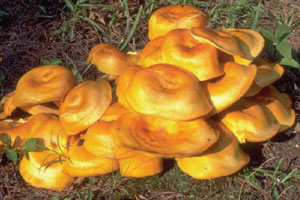
By Dan Zarlenga, Missouri Department of Conservation
October is the essence of autumn. It also embodies the spirit of Halloween. And for many of us, there’s nothing more iconic to Halloween than the Jack-o’- lantern. But did you know there’s also a Jack-o’-lantern mushroom in Missouri? While pumpkins are edible, in the spirit of a spooky holiday, the mushroom Jack-o’-lantern is poisonous.
The Jack-o’-lantern mushroom surely looks the part. It is bright orange to yellowish orange, with a convex cap that becomes flat to funnel shaped with a center that’s sunken in. The smooth skin is similar to that of a pumpkin. Its narrow gills are sharp-edged and descend from the stalk, which is curved… not unlike the stalk of a pumpkin.
In addition to trying to trick us into thinking they’re pumpkins, it’s said that these mushrooms can pull off another Halloween trick; they can glow in the dark, just like a Jack-o’-lantern! The bioluminescent gills of fresh specimens sometimes give off an eerie, faint greenish glow at night.
You can find Jack-o’-lantern mushrooms growing in large clusters at the base of trees, on stumps, or on buried wood from July and throughout October all over Missouri. Eating a Jack-o’-lantern mushroom would most definitely not be a treat, however. Though they are not typically deadly to healthy adults, a mild to severe upset stomach lasting for several days would be the result of making these mushrooms a Halloween snack.
Like trick-or-treaters, Jack-o’-lanterns can masquerade as something else they aren’t too. People often confuse them with the edible and delicious chanterelle mushroom, because Jack-o’-lanterns have a very similar color and shape. Always positively identify any mushroom you intend to eat before doing so!
As if being poisonous wasn’t scary enough, these Jack-o’- lantern mushrooms also feed on dead hardwood trees. They decompose the fallen logs, branches, and underground roots of oaks and other trees. In this way, the mushrooms actually do perform a vital function. They help clean the forest and recycle nutrients back into the soil. So, while bad to eat, they are good for the forest environment.
Historically, some might be surprised to know that carving Jack-o’-lanterns for the Halloween season evolved from an old Irish and Scottish tradition.
In the United Kingdom however, people carved their lanterns out of turnips and rutabagas. In the early colonial days, immigrants from Europe brought the practice to North America. It was then that they began carving the native pumpkins commonly found here instead. The larger pumpkin was much easier to work with than the tiny turnip and afforded a lot more creativity. The name Jack-o’-lantern associated with pumpkin carving emerged in the U.S. around the mid-1800’s. And the rest is Halloween history.
For a Halloween trick this month, why not take a hike through the woods, and try to spot the Jack-o’- lantern mushroom lurking on a forest floor. You’ll know it’s doing the vital job of recycling while masquerading as a pumpkin. Just don’t try to make a “treat” out of it. Save that for your Halloween candy.


